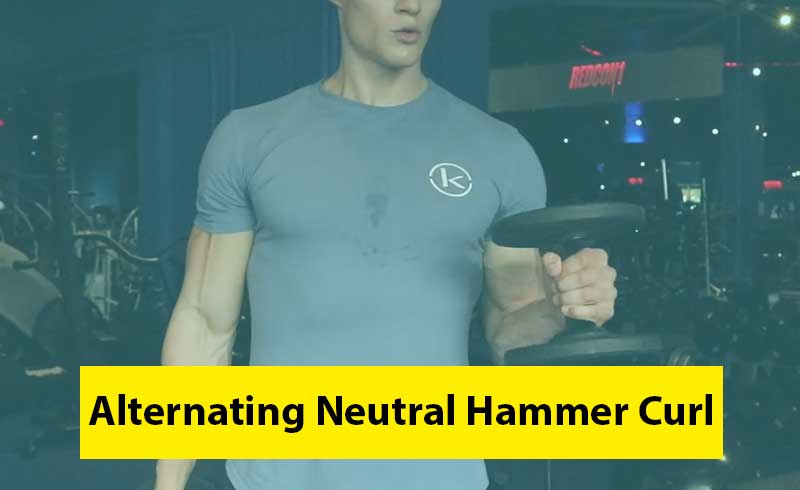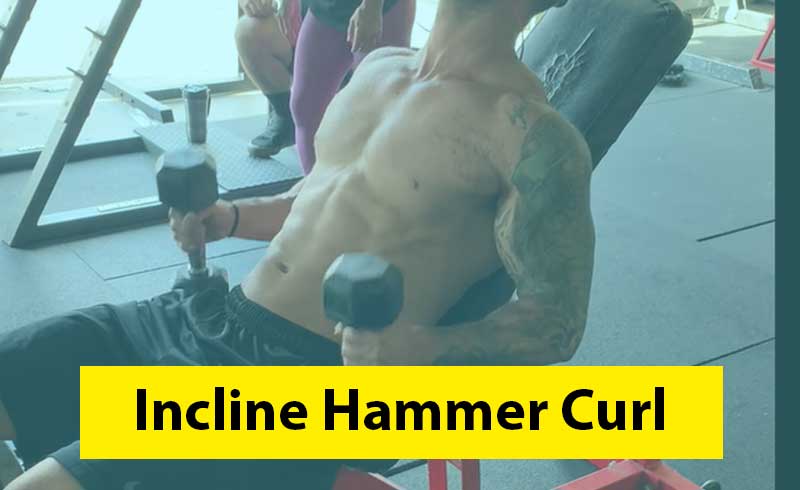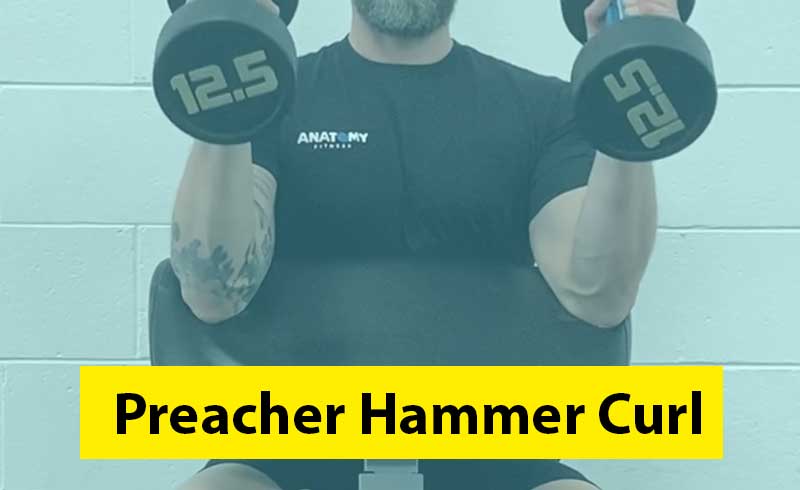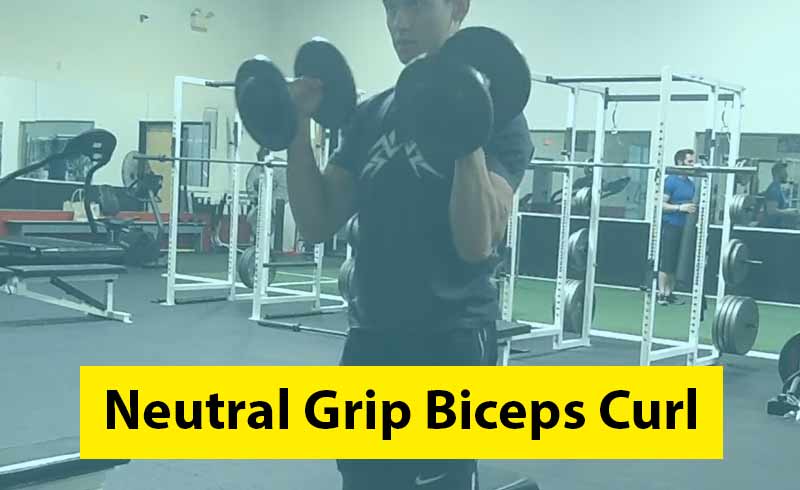The hammer or neutral grip curl and the bicep curl are two of the most popular arm isolation exercises, and both are essential for building strong biceps.
Although many forms of exercise target the same muscle groups and use similar mechanics, getting the most out of your workout routine requires an understanding of where each technique differs.
Thankfully, you don’t have to choose between the neutral curl and the bicep curl; both are useful in their own ways, and you may find that doing them together is more beneficial than using each one.
Related: Dumbbell Exercises To Build A Good Biceps Peak
Exercise details
- Also known as: Dumbbell hammer curl
- Exercise type: Strength workout
- Body type: Arms
- Level: Intermediate
- Main targets: Biceps brachii, brachialis, brachioradialis
- Secondary targets: Forearm extensors, forearm flexors
- Compound/Isolated: Isolated
- Force type: Pull
- Required equipment: Dumbbells
What is a Neutral Grip Curl
The neutral grip curl is an isolated exercise that may be done bilaterally or unilaterally to build muscle and strength in the muscles that connect to the humerus, forearm, and ulna.
Hammer neutral curls are differentiated from bicep curls primarily by the fact that the exerciser maintains a neutral grip throughout the repetition, as opposed to the supinated grip typically used for the bicep curl.
This change in grip causes a slightly different muscular activation and resistance between the biceps brachii and the forearm muscles.
The hammer curl or neutral curl, like the appropriately titled bicep curl, is an excellent way to enhance your biceps brachii, a pair of muscles located on each side of your upper arm.
How to perform Neutral grip biceps curl
The following is a more in-depth, step-by-step explanation of how to do the neutral grip curls correctly.
These are only guidelines, so feel free to experiment with different beginning locations until you find what works best for you.
If you’re ready to get in shape and practice some hammer biceps curls, here’s how to do them correctly:
Before beginning, choose a weight that you can lift with good form for two to three sets of eight to twelve reps. Choose a weight that challenges you without preventing you from doing each set and rep with proper form.
- Grab a pair of dumbbells and stand with your feet about shoulder-width apart and your knees slightly bent.
- Keep your head and neck in a relaxed, upright posture. To avoid cracking an egg under your chin, you should maintain your chin tucked into the side of your neck for the entirety of the exercise.
- Set both feet firmly on the ground to provide a sturdy base of support for the rest of your body. Your weight must be shared equally between your two legs.
- With your hands towards your legs, hold the dumbbells at your sides. Keep your arms completely extended and your elbows slightly bent.
- Put pressure on your hip flexors and shoulders as you tighten your abs. Keeping your body straight requires a strong and sturdy core. This is the starting point for all of your repeats.
- Keep your upper arms static while squeezing your biceps and bending your elbows until your lower arms contact your upper arms. The dumbbells’ final resting place should be fairly near to, but not on, your shoulders.
- At the peak of the exercise, squeeze your biceps and hold the contraction for a few seconds.
- Reverse the movement by slowly extending your elbows to return to the starting position, and pause there for a moment before attempting another rep.
Muscles Worked On Neutral Grip Curl
While the hammer neutral curl is most often thought of as an isolated exercise for the biceps, it really targets the outer or long head of the biceps muscle, increasing thickness in the upper arm, mostly due to the neutral grip position, which shifts the force in such a way.
In addition to strengthening the brachialis, which is located beside the biceps brachii on the upper arm’s outer side, this movement also activates and trains the brachioradialis, which is located at the top of the forearms.
The thickness and sharpness of the biceps, as well as the exerciser’s pulling power, which would be used in the barbell row or pull-up, would greatly benefit from the development of these two muscle groups.
Neutral grip curl variations/alternatives
1. Alternating Neutral Hammer Curl
 If you feel that a single set of hammer curls requires too much concentration on the form to be effective, you may want to try doing alternate sets instead.
If you feel that a single set of hammer curls requires too much concentration on the form to be effective, you may want to try doing alternate sets instead.
If you can’t raise both arms at once, try raising only one at a time.
Lift your right and lower it, then your left. Continue switching sides.
2. Incline Hammer Curl
 Another alternative is to do the neutral grip curl while sitting on an incline bench. Starting with the arms behind the hips while sitting is a good way to decrease the load on the shoulders.
Another alternative is to do the neutral grip curl while sitting on an incline bench. Starting with the arms behind the hips while sitting is a good way to decrease the load on the shoulders.
Besides it, the same motions are used. Raise the dumbbells to your shoulders and lower them back down.
3. Preacher Hammer Curl
 A preacher bench may be useful for this workout and other similar exercises like a preacher curl in a standing position and alternating preacher curls, which is why some people choose to use one.
A preacher bench may be useful for this workout and other similar exercises like a preacher curl in a standing position and alternating preacher curls, which is why some people choose to use one.
With a preacher bench, which is an inclined, curved armrest, you may isolate the upper arm, allowing you to lift more weight and focus on the biceps.
To ensure that the top of the armrest is contacting your armpits, you may need to make some adjustments.
Let your upper arms rest on the padding, stretch your elbows, and grip the weights with your palms facing each other.
Raise the dumbbells up toward your shoulders and back down again.
Conclusion: Is a neutral grip good for the biceps?
biceps curl with a neutral grip engages both the major and secondary muscular groups.
In addition, while doing this exercise with a neutral grip, you activate a higher number of upper-body muscle groups.
The obliques, as well as the biceps, pectorals, triceps, and obliques as well.
- Bench Press Calculator - April 22, 2024
- Press to Handstand: Ultimate Step-by-Step Guide - April 22, 2024
- Cable Press (How To Do, Benefits, Targeted Muscles, Alternative) - April 22, 2024

